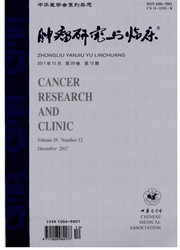

 中文摘要:
中文摘要:
目的构建hTERT启动子调控的HSV—TK基因重组腺病毒载体系统,观察Ad—hTERTp—HSV-TK/GCV自杀基因系统对肝癌细胞的杀伤作用。方法将穿梭质粒pSU-Tp-TK与腺病毒骨架质粒pBHGE3共转导至HEK293细胞,利用细胞内同源重组法构建出hTERT启动子调控的携带TK基因的复制缺陷型腺病毒Ad—hTERTp—HSV—TK载体系统;将不同感染复数(MOI=1、10、100、1000)的重组腺病毒Ad—hTERTp—HSV—TK感染肝癌细胞HepG2及正常肝细胞L-02,加入不同浓度的GCV(0、1、10、100、1000ug/ml),MTT、法检测细胞活性。结果HEK293细胞出现病毒空斑,提取病毒DNA,经PCR鉴定正确后扩增、纯化,滴度为1.5×10^10pfu/ml;MTT法检测到Ad—hTERTp—HSV-TK/GCV能靶向杀死肝癌细胞HepG2,且细胞存活率随着病毒滴度和GCV浓度的增加而降低。结论该实验构建的Ad—hTERTp—HSV—TK载体系统,可靶向抑制肝癌细胞HepG2,而对正常肝细胞L-02几乎无影响。
 英文摘要:
英文摘要:
Objective To construct the recombinant adenovirus vector with hTERT-HSV-TK and observe the killing effect of Ad-hTERTp-HSV-TK/GCV system on hepatocellular carcinoma cells. Methods A recombinant replication defective adenoviral vector of Ad-hTERTp-HSV-TK was constructed via homologous recombination which both shuttle plasmid pSU-Tp-TK and adenovirus backbone plasmid pBHGE3 transfected into the HEK293 packaging cells. Then the Ad-hTERTp-HSV-TK was amplified and purified through PCR. The activity of the HepG2 cells and the L-02 cells were tested by methyl thiazolyl terazolium (MTF) after they were transfected by the recombinant adenovirus of different multiplicities of infection (MOI) and then were added GCV of different concentration. Results The recombinant replication defective adenoviral vector of Ad-hTERTp-HSV-TK were identified by PCR successfully. The viral titer was 1.5×10^10 pfu/ml after amplification attd purifieation. The HepG2 ceils were targetedly suppressed by Ad- hTERTp-HSV-TK/GCV system. The smvival rate of cells decreased gradually along with the increase of the MOI and the GCV' s concentration. Conclusion The recombinant replication defective adenoviral vector of Ad-hTERTp-HSV-TK can inhibit the HepG2 cells significantly, but has not influence on the L-02 cells.
 同期刊论文项目
同期刊论文项目
 同项目期刊论文
同项目期刊论文
 期刊信息
期刊信息
